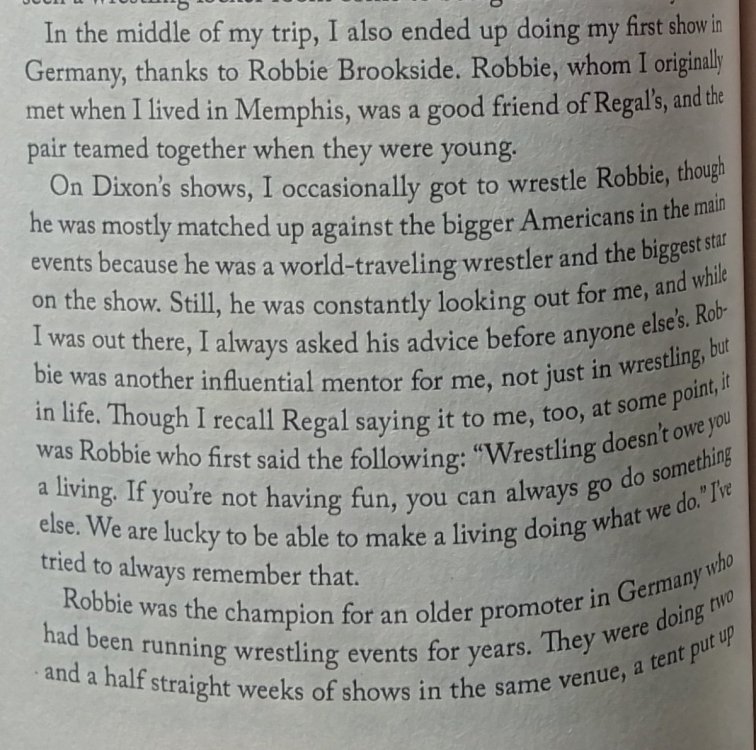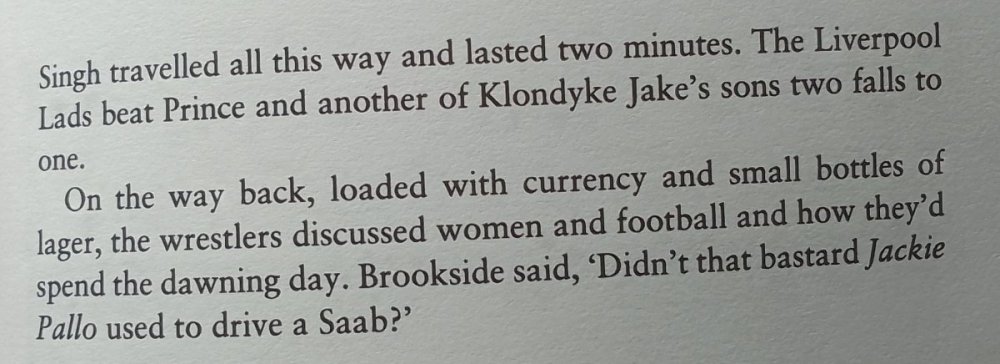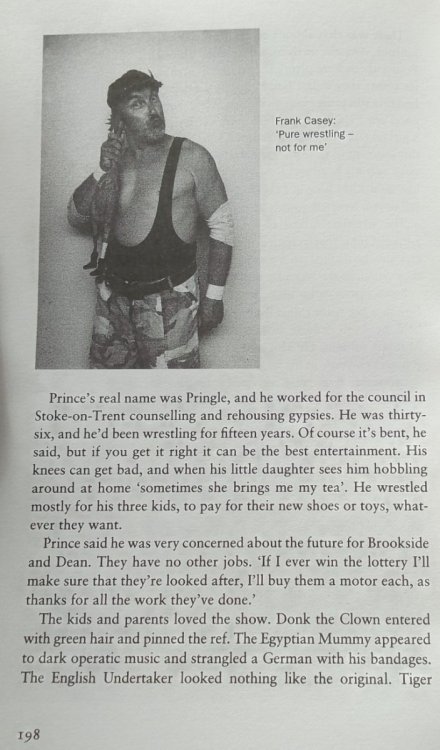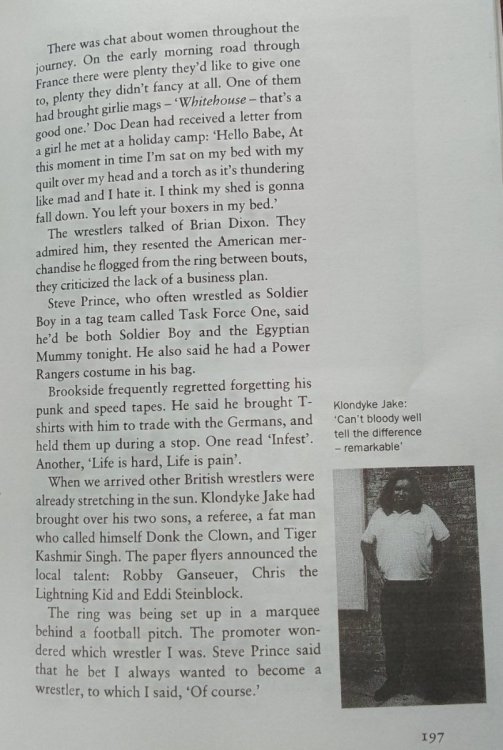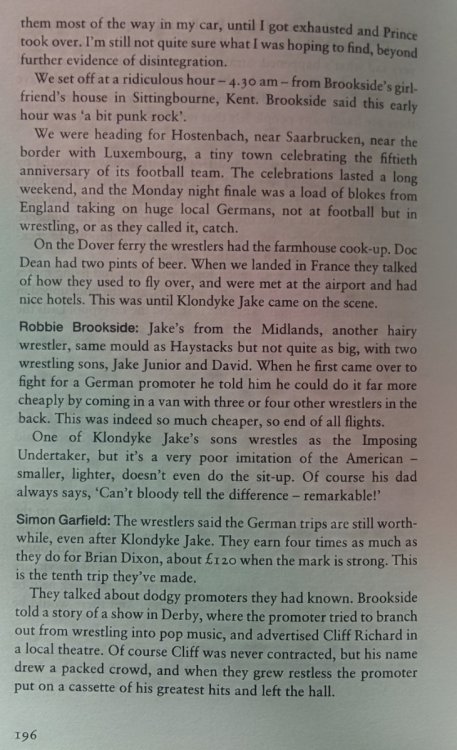
David Mantell
Members-
Posts
2111 -
Joined
-
Last visited
Content Type
Profiles
Forums
Blogs
Everything posted by David Mantell
-
The Beginner's Guide To British Wrestling
David Mantell replied to ohtani's jacket's topic in Megathread archive
Slightly disappointing bout. If anything it's Clay that loses his cool in this one- after a couple of rounds of various sleeper holds being put on him (including a headscissor sleeper) he snaps and starts refusing to release holds. eventually getting a public warning. He calms down after this but holds are worked longer with hardly any reversing. Clay gets the one fall required with a bog standard double legdive press. He and Trood shake hands but referee Max Ward is shooting daggers at Clay and a significant minority of the audience are in no mood to forgive either. The video contains a lengthy advert break for financial services products. You may wish to FFWD from 12:00 to 16:00 -
The Beginner's Guide To British Wrestling
David Mantell replied to ohtani's jacket's topic in Megathread archive
I decided to rewatch this after the recent 1967 find.. A good technical bout until it stops being one, which as Kent says was becoming something of a running issue with Clay's opponents. I should think it's clearer now from the StClair bout what Kent saw in Clay. I wonder if my present day fave Jordan Breaks is a fan, Clay does what became Jordan's ankle scissor trip. It's a one fall bout so I assume you meant the first two rounds, OJ. Mildly amusing spot near the end when all three men including referee Tony Mancelli (same as the 1967 bout) go over the top rope together in one bundle. Personally I quite like the pinfall - Thompson turns himself over in a side chancery, does a French Catch style reverse snapmare over the top of Macra then lands behind him to get a folding press. Even if it comes out of nowhere, it's still an ingenious piece of work. -
The Beginner's Guide To British Wrestling
David Mantell replied to ohtani's jacket's topic in Megathread archive
https://wrestlingheritage.co.uk/alan-dennison/ -
The Beginner's Guide To British Wrestling
David Mantell replied to ohtani's jacket's topic in Megathread archive
I've checked one results source and found at least two rematches already, both of them tag contests where Alan was teamed with his regular Dennisons tag partner Cyanide Sid Cooper. WALTHAMSTOW – 20/4/72. …..Lennie Hurst and Johnny Kwango beat The Dennisons. BELLE VUE – 29/4/72. The Dennisons beat Honey Boy Zimba and Johnny Kwango. Bear in mind the source in question is very incomplete and doesn't seem to include the TV taping that produced the Kwango/Dennison bout. So I expect there were plenty more. Dennison's heat came from his surly growling sadistic psychotic performance all through the bout. Having him celebrate a tainted win like it was some kind of triumph simply topped it off. -
Caswell Martin had one of my all time favourite bouts this same year at the Royal Albert Hall with Marty Jones. Along with the Birmingham Steve Logan, he is one of my two picks for wrestlers who were never champions but frankly should have been. Achim Chall, an aging contemporary of Axel Dieter was not as skilled an opponent as Jones but he lets Cas show all his tricks to the German audience and they like it. Like the Jones match, this ends on a refused-TKO no contest(after Martin suffers an arm injury.) He German audiences appreciate the spor.tsmanship like British audiences do. Two odd things. 1) During the break after round 1 the DJ puts on 1978 Christmas hit Mary's Boy Child by Boney M even though it is early September. 2) The seconds wear red and blue V necked shirts as per their corner. The red corner second looks like a Star Trek redshirt!
-
The Beginner's Guide To British Wrestling
David Mantell replied to ohtani's jacket's topic in Megathread archive
I imagine there was a whole string of rematches around the country. That was how it was usually done and this was, in American terms, the angle that set them up. How well they drew isn't really the issue. The issue is that it is what it is, a set up match designed to get Dennison heat against one of the most beloved babyfaces in the country at that time. As an exhibition of how cruel, arrogant, unpleasant and ultimately cowardly when the crunch (headbutt in this case) came Alan Dennison was (until the day the 17 year old Dynamite Kid sorted him out) it's a great heat vehicle. -
The Beginner's Guide To British Wrestling
David Mantell replied to ohtani's jacket's topic in Megathread archive
I think it's best to put oneself in the place of the weekly British viewer rather than viewing everything through the jaundiced eye of a modern smart fan, especially the American concept of what constitutes wrestling smartness. It is what it is, a heel gets a screwy win, brags about it as an achievement, gets heat and sets up a revenge match. -
The Beginner's Guide To British Wrestling
David Mantell replied to ohtani's jacket's topic in Megathread archive
Knockout finishes are ABSOLUTELY created equal in Britain/Europe . Yes you can have screwy knockout finishes designed to create heat for a rematch but you can equally have screwy pinfalls with either wrestler's foot or feet on the ropes, tights pulled, pins overturned by a tag partner while the referee is distracted, the lot. And of course a heel like Dennison is going to brag about it as if he'd destroyed the guy. A Knockout finish has a different importance from a countout finish in America. The two audiences were brought up with different ways of viewing what a knockout/countout signified. It's a different wrestling culture, not a defective wrestling culture, and it should be assessed on its own terms, not on American Wrestling fan expectations. In 1966 at the Victoria Hall Hanley, Kendo Nagasaki defeated and unmasked his mentor Count Bartelli in a loser lose mask match, after 20 years of Bartelli under a mask, on a very similar finish to this with Bartelli narrowly failing to beat the count. That match is considered legendary yet it ends the same way as this one. -
-
Simon Garfield's account of British Wrestlers making the traditional trip to Germany. This was from 1995
-
Thanks. Subscribed.
-
The Beginner's Guide To British Wrestling
David Mantell replied to ohtani's jacket's topic in Megathread archive
Strange review - Kwango lost by Knockout which, as we've discussed, was considered a more emphatic way to win than two falls or submissions, So one of them DID lose. This is the one full TV bout we have of Dennison's heel days (all we otherwise have of Bad Alan is some footage from The Wrestlers docu of 1967, silent footage of The Dennisons - Alan plus Sid Cooper - going heel Vs heel with Street and Barnes plus the 1976 match with Dynamite Kid that was Alan's Damascus Road moment to turning good. Most older British fans on message boards prefer him as the snarling bullying heel rather than the somewhat sanctimonious blue eye (as a kid I sided with heel Jim Breaks in their feud.) The story of this bout was Dennison the nasty cruel man doing the dirty on Kwango but occasionally getting his comeuppance from a Kwango headbutt. Dennison was not just the sadist but a cowardly sadist who couldn't handle retribution but reverted back to his jeering self the moment he was safe. His taunting of Kwango as "a BAY-BEE!!!" and rolling up a second's towel into a maternity wrap and rocking it to sleep was particularly memorable. The moustache and the grown out stubble of his alopecia-scarred scalp made him look extra cruel and hellish. A competitive heel Vs blue eye match ending in a tainted but officially definitive win for the hated heel, like Flair outing his feet on the ropes to get a winning pinfall. Dennison was billed as the man Possessed By The Devil - until he had his soul saved by of all people Tommy Billington. -
The Beginner's Guide To British Wrestling
David Mantell replied to ohtani's jacket's topic in Megathread archive
Thanks for that. I have some of those clips from years ago on the Pathe site. They tend to crop down to what the film makers considered amusing spots with cynical commentary, so they can be hard for a fan to watch. -
You could be right, I'll have a look at some point. I stick to my guns about the general point re. Technical Vs Brawling. Forgot to mention it's nice to see Germany had seconds like the UK and France. P.S. Have searched YouTube, no sign of any other Axel v Moose solo bout. If you can find one, you're doing better than me.
-
Hanover 1985 triple tag match (as we Brits called them.) Two of the six wrestlers here would have been familiar figures to me as a child wrestling fan in 1980s Britain. Rasputin was longtime Daddy fodder (with occasional appearances on Reslo between times) until a 1988 Battle Royal filmed days after WM4 saw Rasputin playing Bret Hart to Giant Haystacks's Bad News Brown, leading to a DQ win for the Mad Monk that I think I posted to the British thread or else the Why Is America Assumed To Be The Centre Of The Wrestling Universe thread which saw crowds side with Rasputin. The other familiar face would be Jorg Chenok or Baron Von Chenok, who showed up on FA Cup Final Day 1985 to drop the European Welterweight title he allegedly won off Wolfgang Saturski in 1981, to Danny Boy Collins. That time Chenok was the subtle heel like Bret Hart at Summerslam 92. Here he is a good guy. Not a lot to report technically about this bout. Good family entertainment but nothing much scientific. The good guys win 2-1 and that's about it. Crowd get into it heavily.
-
The Beginner's Guide To British Wrestling
David Mantell replied to ohtani's jacket's topic in Megathread archive
Interesting. I wonder which sale customer as of 1970 had colour but couldn't cope with VT? Maybe somewhere with 525 lines/NTSC? We know from the Faulkner Vs McMichael 1972 bout they were still doing B/W prints a couple of years later. I also wonder whether or not ITV have that bout in their video archive - if not, that could be the one surviving copy. -
I prefer scientific matches to brawls any day. Still there are a couple of good little moments in there for a purist like me to look out for. Moose was no technician and didn't have much of a clue what to do when Dieter put on a headscissor and clearly called for a counter. So in the end Moose put on a headscissor of his own, leaving them in a 69 position. So Axel let go, moved himself into the guard and folded Morowski's headscissor into a neat Frank Gotch toehold. The other good moment was with the finish where Dieter used the same full nelson scissor finish as the Zrno bout to put Mooser the Looser (sorry @sergeiSem ) out of town and out of the VDB and possibly back to North America where bookings awaited..
-
The Beginner's Guide To British Wrestling
David Mantell replied to ohtani's jacket's topic in Megathread archive
Okay it calls him that, but it's not like he did a complete Papa Shango gimmick act. The cultural stuff would go out the window ready for the start of Round 1 and from that point he would be a straight up wrestler (with maybe a hint of personality like a Vic Faulkner - I'm guessing "him give up?" was something he used to say in gym shoots which got a laugh from the boys so he did it in the ring). Maybe he played it up a bit more against a heel - the two Masambula bouts we have on YouTube are very much clean scientific sportsmanly matches, this one and Masambula/Zimba vs the Royals from June 1970. He did have a headbutt (like nearly every wrestler of African heritage in the Western World in that era from Bobo Brazil to Johnny Kwango to Mammouth Siki.) which he refuses to use in this bout and IIRC against the Royals too. Interesting about the 16mm print- a B/W copy, I'm guessing? Although the original transmission would have been colour, being August 1970. -
The Beginner's Guide To British Wrestling
David Mantell replied to ohtani's jacket's topic in Megathread archive
Masambula wasn't exactly a "witch doctor", just an African wrestler with an African ring name and who wore a jaguar skin to the ring and did a quick tribal dance when introduced. Once the matches were underway he was a no nonsense technical wrestler (apart from his catchphrase "Him say yes?" to ask the referee to check for a submission.). There is a review on here of a bout with Leon Arras (so this is not his only singles bout in circulation) and he and Honey Boy Simba have a good tag loss to the Royal Brothers. His career ended in the mid 70s when he landed spine first on a ring post on TV, it didn't cripple him as such but his injuries were nasty enough to trigger a kayfabe busting court case. Journalists afterwards tried to get him to spill more beans but he refused, saying it would ruin the public's enjoyment of wrestling if they knew too much. He already had a couple of missing fingers, allegedly from an encounter with a knife wielding burglar while a policeman in Gambia. Masambula 's "wheel barrow" escape from a gurd hammerlock is a sight to behold, shuffling out of a pinning predicament on his back. He gets his equalising pinfall with a neat sunset flip then celebrates by hand-standing on the top turnbuckle - a trick used as a ball-style trap by 21st century old school style British wrestler Dean Allmark. He also forces Charles upwards by the jaw to prise off a "headlock and strangle" (sleeper.) from him. He has Charles neatly tied up and ready for a headbutt but sportingly declines to administer it. This appears to be from the same 1972 TV taping as Adrian Street Vs Jim Breaks. That was also a 1-1 Broadway. Nobody really complained about it with either match and clean bouts that end on a refused TKO no contest were seen as a truncated version of the same finish. It's a midweek late evening broadcast, the same timeslot as in France but by no means a graveyard slot in either country.. -
Prince Zefy, probably my favourite of end of terrestrial TV/ post terrestrial TV period of French Catch, visits another European Territory, the CWA in Sept 91. Salvatore Bellomo was once Tino Salvatore, Italian babyface/blue-eye, appeared on World of Sport January 1973, made it to the Backlund era WWF where he got his later name stuck around for Hulkamania but never got the push. Mostly famous here in Britain for being squashed in 15 seconds by Kamala in bout 2 of the first ITV American WWF special in January 1987. Later rebranded inthe Savoldi ICW as Wildman Bellomo, a cross between Bruiser Brody and a Roman centurion, and eventually brought the act back to Europe whee he made it onto British TV again via Reslo as well as the CWA tournaments. Typical skilled little man tries his luck with big monster match. Zefy appears to have Sal nailed with a flying bodypress but the referee is slow going down and Bellomo uses the extra time to roll through and upturns the pin attempt a la Richter/Kai at WM1.
-
Another case in point, an all Old Catch alumni match on New Catch. (Kato the Gypsy being the former Kato Bruce Lee and I *believe* the Grim Rocker being the former Eliot Frederico Le Rocky Du Ring). Gordon and Zefy have it in the bag until Flesh fires a dropkick and Grim Rocker pulls the referee in the way and it's Flesh who gets the blame - from a posse of 3 referees including Charley Bollet, brother of Andre Bollet.
-
The Beginner's Guide To British Wrestling
David Mantell replied to ohtani's jacket's topic in Megathread archive
RTE in Ireland never had its own wrestling show, but apart from watching World of Sport on the UTV and HTV signals, Irish wrestling fans could get the S4C signal for Reslo. As a result Orig Williams toured Ireland regularly, even after Reslo's 1995 demise, last visiting with a WWF tribute tour in the early Noughties. The tours meant occasional features on Irish TV news. Here is one from 1989 featuring (I think) Giant Haystacks and Danny Collins Vs Fit Finlay and Blondie Barrett, Princess Paula Vs Debbie Drake and an interview with Jack Flash Davey: Also wrestlers including Haystacks appeared on chat shows. Notice Haystacks struggle to explain his name without mentioning William D. Calhoun. Even before Reslo, Stax would visit Ireland and give RTE a whiff of the kicks they would never know, such as this 1978 bout with Jack Flash Sherlock: -
Talking of which, does anyone else in here think 80s South African Wrestling rather resembles the CWA?
-
Axel Dieter Junior goes BALLISTIC if you mention his dad's pistol waving antics - or the dog food pie.... Oh and look who old man Axel is tagging with in this next bout! "Pull the ****ing trigger" then? @ohtani's jacket erm, it goes to a time limit draw. I guess these 30-40 min tags had spread eastwards across the Rhine. Not a scientific classic but the German fans lapped it up. Odd to hear fans chant "ooh-fo, ooh-fo" - there have been many UFOs in wrestling history but most of them were heels, often masked. Not sure how this is the best European tag match. Three Americans in the ring makes for not a lot of counters/escapes/reversals. Early on Dieter has an opponent in a headscissor but he has to let go in the end as they don't know any escape move. My vote for best European tag match goes to the Royal Brothers Vs the StClair Brothers from 1971. Colour signal on @sergeiSem's copy is badly deteriorated due to age or low generation Ed Wiskowski would later learn how to because racist South African colonel in Germany off Shaun Brody. (see his ,watch with Johnny Saint on the British thread.) I like the bit at the end where Moose does powerlifts with the ring steps a la Dingo Warrior prior to the babyface turn.
-
Mike Zrno Vs Axel "Only One Shooter Here" Dieter, VdB, 16th October 1981 Hanover. Gets off to a good scientific start. Dieter gets on the French style flying headscissors counter to armbar and takes Zrno down but Zrno goes into a headstand in the scissors and pushes up with his arms to pull his head free to a cork from a bottle. Zrno gets a hammerlock on Dieter which Axel converts to a side headlock but Zrno goes into a bridge then flips back into his original hammerlock. Zrno returns the favour with the headscissors of his own in round 2 but he lands too near the ropes. Excellent bridge from Zrno and a Clay Thompson style use of an ankle scissors to pull apart Dieter's headscissors in round 3. Dieter gets an odd but effective hold on for sometime in round 4 where he pulls back Zrno's arms behind him like a surfboard and then scissors both arms and the shoulders too, like a full nelson done with the legs. In the end the time limit on the final round goes at a fairly random moment with the score at 0-0. Remembering both Bret Hart and Dynamite Kid's comments about Dieter's egotistical style of booking. I feel grateful for small mercies. I guess this and Zrno Vs Steve Wright from 1988 is the typical German style of clean match. Not as intricate as the best British clean matches, not as acrobatic and flamboyant as Petit Prince Vs Michel Saulnier in France. A somewhat slower but worthy style of scientific bout. ********* P.S. So it's October 1981. Prince Charming by Adam and the Ants, Tainted Love by Soft Cell and Chant No.1 (I Don't Need This Pressure On) by Spandau Ballet have all been major hits the last 2-3 months. And what does the DJ play? Green Door by Shakin' Stevens! Bah.
